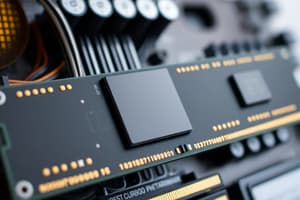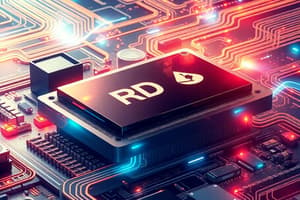Podcast
Questions and Answers
What is the primary function of a computer?
What is the primary function of a computer?
- To act as a paperweight
- To store, retrieve, and process data (correct)
- To only display videos
- To generate electricity
Which of the following is considered computer hardware?
Which of the following is considered computer hardware?
- Antivirus Software
- Monitor (correct)
- Web Browser
- Operating System
What component is often called the 'brains' of the computer?
What component is often called the 'brains' of the computer?
- CPU (correct)
- RAM
- Hard Drive
- Motherboard
What is the purpose of RAM in a computer?
What is the purpose of RAM in a computer?
Which of the following storage devices uses flash memory?
Which of the following storage devices uses flash memory?
Which of these is an example of an input device?
Which of these is an example of an input device?
What is the role of an operating system (OS)?
What is the role of an operating system (OS)?
Which of the following is an example of a computer application?
Which of the following is an example of a computer application?
What type of computer is designed for individual use?
What type of computer is designed for individual use?
Which type of computer is used for complex calculations at high speeds?
Which type of computer is used for complex calculations at high speeds?
Which computer architecture uses a single address space for both instructions and data?
Which computer architecture uses a single address space for both instructions and data?
What is the smallest unit of data in a computer?
What is the smallest unit of data in a computer?
What is a group of 8 bits called?
What is a group of 8 bits called?
What type of network connects computers in a limited area like a home or office?
What type of network connects computers in a limited area like a home or office?
What is the purpose of a firewall?
What is the purpose of a firewall?
Flashcards
What is a computer?
What is a computer?
An electronic device that manipulates information or data.
What is Hardware?
What is Hardware?
The physical components of a computer system.
What is the CPU?
What is the CPU?
The primary component that processes instructions; often the 'brains' of the computer.
What is RAM?
What is RAM?
Signup and view all the flashcards
What are Storage Devices?
What are Storage Devices?
Signup and view all the flashcards
What are Input Devices?
What are Input Devices?
Signup and view all the flashcards
What are Output Devices?
What are Output Devices?
Signup and view all the flashcards
What is software?
What is software?
Signup and view all the flashcards
What is the Operating System (OS)?
What is the Operating System (OS)?
Signup and view all the flashcards
What are Applications?
What are Applications?
Signup and view all the flashcards
What is a Local Area Network (LAN)?
What is a Local Area Network (LAN)?
Signup and view all the flashcards
What is the Internet?
What is the Internet?
Signup and view all the flashcards
What is Malware?
What is Malware?
Signup and view all the flashcards
What are Firewalls?
What are Firewalls?
Signup and view all the flashcards
What is Encryption?
What is Encryption?
Signup and view all the flashcards
Study Notes
- A computer is an electronic device that manipulates information or data
- It can store, retrieve, and process data
- Computers are used for typing documents, sending emails, playing games, and web browsing
- Computers can also be used to edit or create spreadsheets, presentations, and videos
Hardware
- Hardware refers to the physical components of a computer system
- This includes the monitor, keyboard, mouse, hard drive, and motherboard
Central Processing Unit (CPU)
- The CPU is the primary component of a computer that processes instructions
- It is often called the "brains" of the computer
- It executes instructions that make the computer work
Random Access Memory (RAM)
- RAM is a type of computer memory that can be randomly accessed
- Any byte of memory can be accessed without touching the preceding bytes
- Used to store data and code that the CPU is actively using
Storage Devices
- Storage devices are used to store data and information permanently
- These include Hard Disk Drives (HDDs) and Solid State Drives (SSDs)
- HDDs use magnetic platters to store data, while SSDs use flash memory
Input Devices
- Input devices provide data and commands to the computer
- Common examples are the keyboard, mouse, scanner, and microphone
Output Devices
- Output devices display or output data from the computer
- These include the monitor, printer, and speakers
Software
- Software is a set of instructions, data, or programs used to operate computers and execute specific tasks
- It is the opposite of hardware, which describes the physical aspects of a computer
Operating System (OS)
- The OS is the most important software on a computer
- It manages the computer's memory, processes, and all of its software and hardware
- Examples include Windows, macOS, and Linux
- It provides a user interface, which enables users to interact with the computer
Applications
- Applications are software programs designed to perform specific tasks
- These include word processors, web browsers, media players, and games
Computer Types
- Computers come in various forms that are designed for specific purposes and environments
Personal Computers (PCs)
- PCs are designed for individual use
- They include desktop computers, laptops, and tablets
Servers
- Servers are designed to provide services to other computers over a network
- They are used for tasks such as hosting websites, storing data, and running applications
Mainframes
- Mainframes are large, powerful computers used by organizations to process large amounts of data
- They are often used in banking, healthcare, and government sectors
Supercomputers
- Supercomputers are the most powerful type of computer
- They are designed to perform complex calculations at high speeds
- They're often used in scientific research, weather forecasting, and simulations
Embedded Systems
- Embedded systems are specialized computers embedded within devices
- They control the functions of the device
- They are found in appliances, vehicles, and industrial equipment
Computer Architecture
- Computer architecture refers to the internal organization of a computer
- This refers to how its components are interconnected, and how they interact to execute instructions
Von Neumann Architecture
- A computer architecture based on a description by John von Neumann
- It utilizes a single address space for both instructions and data
- Most modern computers are based on this architecture
Harvard Architecture
- Harvard architecture uses separate memory spaces for instructions and data
- This allows simultaneous access to both, improving performance
- Often used in embedded systems and digital signal processing
Data Representation
- Computers represent data in binary format, using bits (0s and 1s)
Bits and Bytes
- A bit is the smallest unit of data in a computer
- A byte is a group of 8 bits
- These are used to represent characters, numbers, and other data
Number Systems
- Binary (base-2): Uses only 0 and 1
- Decimal (base-10): The standard number system we use
- Hexadecimal (base-16): Uses 0-9 and A-F, and often appears in programming
Character Encoding
- Character encodings are standards for representing characters in binary format
- ASCII: A character encoding standard for representing text
- Unicode: A more comprehensive character encoding standard
- Unicode supports a wide range of characters from different languages
Networking
- Computers can be connected together to form networks, allowing them to share resources and communicate
Local Area Network (LAN)
- A LAN is a network that connects computers in a limited area
- This can be a home, office, or school
Wide Area Network (WAN)
- A WAN is a network that covers a large geographical area
- The Internet is the largest WAN
Internet
- The internet is a global network of interconnected computers
- It uses the Internet Protocol Suite (TCP/IP) for communication
Network Protocols
- Network protocols are sets of rules that govern how data is transmitted over a network
- Examples include TCP, IP, HTTP, and FTP
Computer Security
- Computer security refers to protecting computer systems and networks from unauthorized access, use, disclosure, disruption, modification, or destruction
Malware
- Malware is malicious software designed to harm or disrupt computer systems
- This includes viruses, worms, and Trojan horses
Firewalls
- Firewalls are security systems that monitor and control incoming and outgoing network traffic
- They helps to prevent unauthorized access to a computer or network
Encryption
- Encryption refers to converting data into a coded format to prevent unauthorized access
- It ensures data confidentiality and integrity
Authentication
- Authentication verifies the identity of a user, device, or system
- It often involves the use of usernames, passwords, and multi-factor authentication
Programming
- Programming is the process of writing instructions that tell a computer what to do
Programming Languages
- Programming languages are formal languages used to write computer programs
- Examples include Python, Java, C++, and JavaScript
Algorithms
- Algorithms are step-by-step procedures for solving a specific problem
- They form the foundation of computer programs
Software Development Life Cycle (SDLC)
- SDLC is a structured process for developing software applications
- It includes planning, design, implementation, testing, and maintenance
Studying That Suits You
Use AI to generate personalized quizzes and flashcards to suit your learning preferences.




